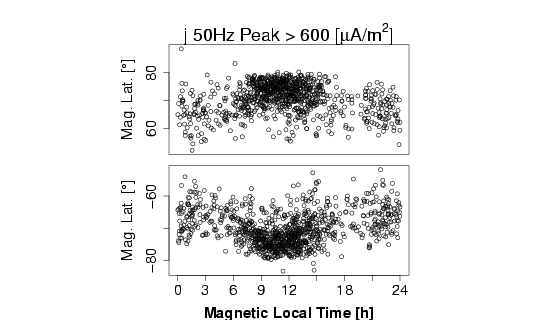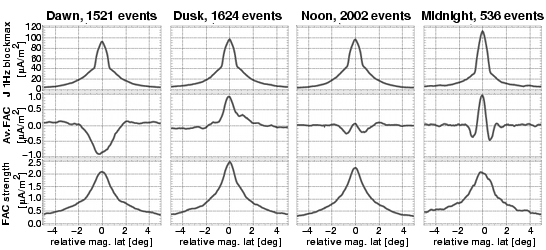Field-aligned currents (FACs) in the auroral zone are observed over a fairly wide range of spatial scales, covering wavelength from 1km to several 100km and, as a general FAC characteristic, the shorter the wavelength the larger the current density (Ritter et al., 2006).
Small-scale FACs are embedded within the large-scale current regions (Region 1 and Region 2), but also in the cusp and polar cap current systems.
After first detection of FACs with instruments on-board the DE and the Viking satellite their importance for the plasma dynamics has been realized. At that time it was not possible, however, to identify the smallest scales carrying the highest currents. The resolution of spatial scale has been continuously reduced to some ten kilometres achieved by sounding rockets and the Akebono spacecraft, finally a few 100m could be reached with the Freja, Ørsted and with the CHAMP satellite. The highest current densities have been observed near the cusp region.
Bursts of very intense kilometre-scale field-aligned currents are observed quite frequently by the CHAMP satellite when passing through the auroral region. While in extreme cases the current density exeed 3mA/m², typical scale sizes are 1km.
The low-Earth, polar orbiting satellite CHAMP monitors FACs down to scales of a couple of 100m, based on its high-precision magnetic field vector data sampled at 50Hz. Most of the strongest events are encountered in the cusp/cleft region, significantly fewer events are found on the night side.

The affected region is typically 15°-20° wide in latitude. Some dependence of the current intensity on the level of magnetic activity, Kp, on the other hand, no dependence has been found on sunspot number, the solar flux level, F10.7 or the solar zenith angle. The latitude, at which bursts are encountered, expands equatorward with increasing Kp. This trend follows well the auroral oval expansion during enhanced magnetic activity.
Small-scale FACs are generally accompanying large-scale FAC sheets, and they are typically associated with Region 1 currents.


